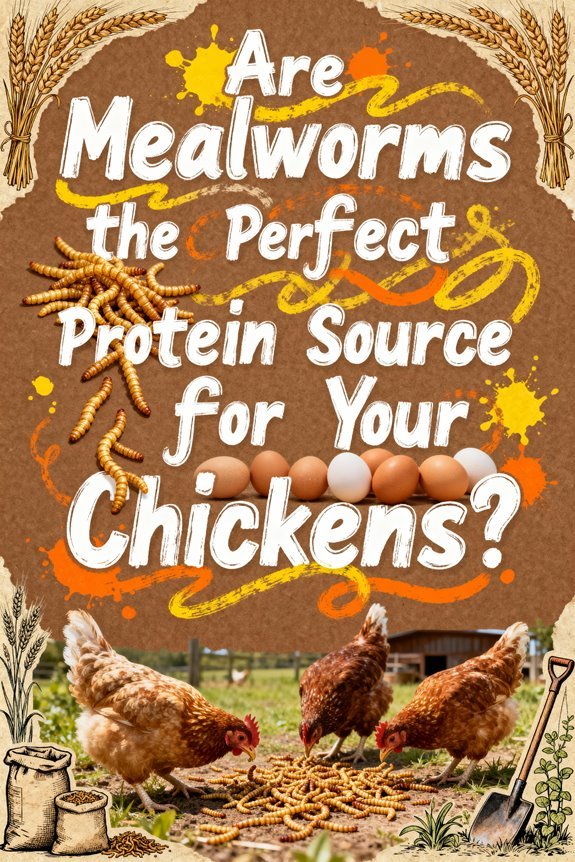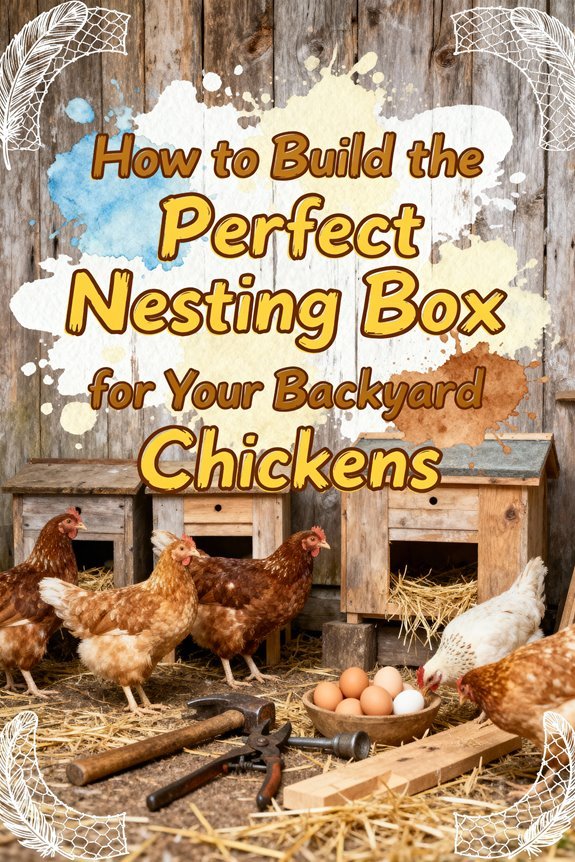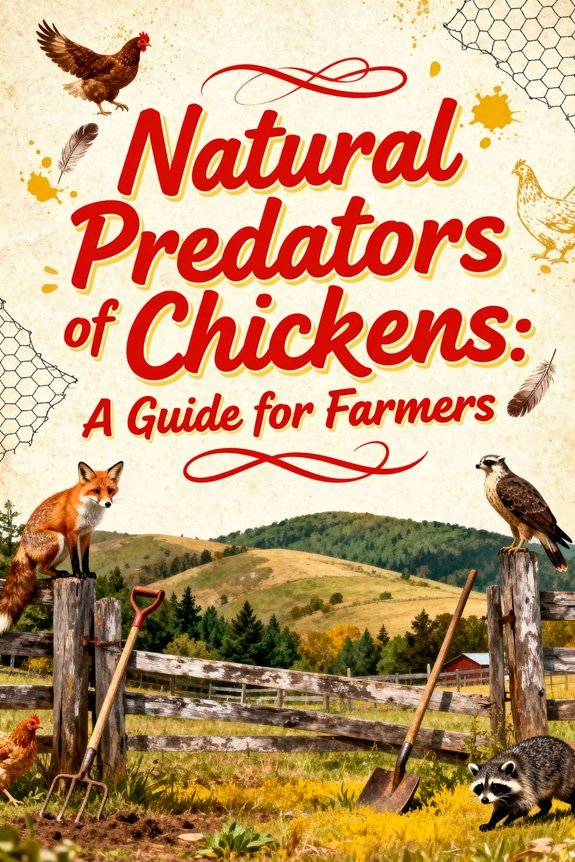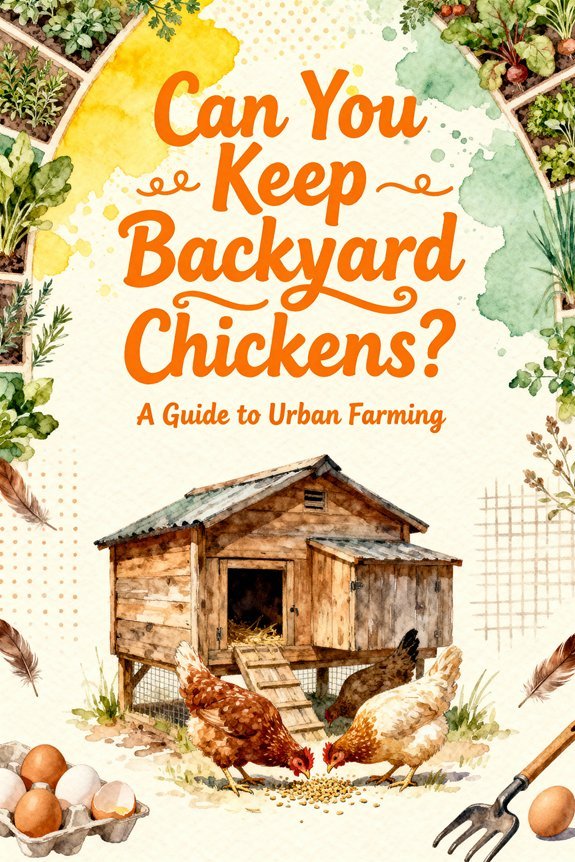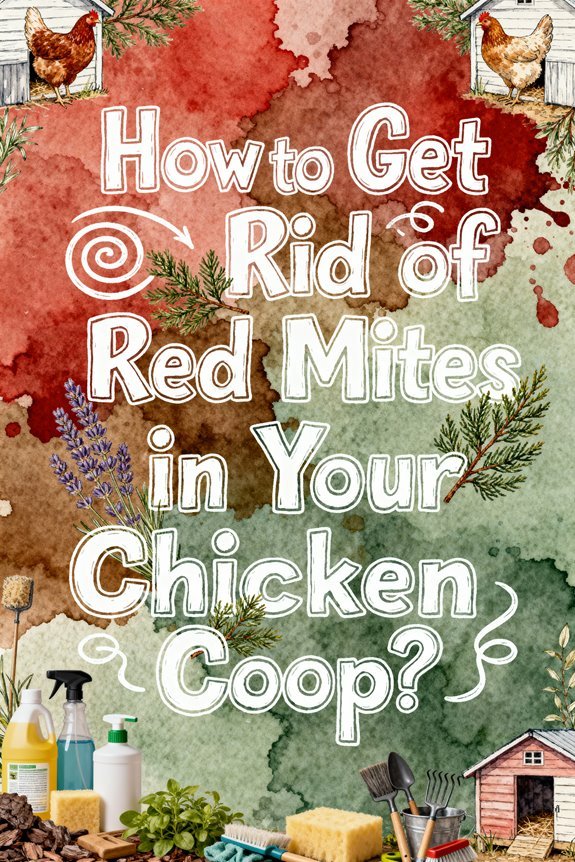Are Mealworms the Perfect Protein Source for Your Chickens?
Mealworms offer your chickens an exceptional protein boost, containing up to 50% protein in dried form and 20% when live. They’re packed with essential amino acids, B vitamins, and omega-3 fatty acids that support egg quality, feather health, and immune function. While you’ll need to limit portions to 10-15 worms per chicken weekly, their sustainable production and natural appeal make them an excellent supplement to your flock’s diet. Understanding proper feeding guidelines will maximize these nutritional benefits.
Why Chickens Love Mealworms: Nature’s High-Protein Treat
While chickens have diverse dietary preferences, their natural attraction to mealworms stems from deep-rooted instinctive behaviors. Their foraging instinct drives them to chase and peck at these protein-rich insects, which mimic the movement of prey they’d encounter in the wild. You’ll notice your chickens’ immediate response to mealworms, whether dried or live, due to their appealing crunchy texture and familiar insect characteristics.
These protein preferences aren’t just about taste – they’re linked to survival. With a remarkable 53% protein content, mealworms satisfy your chickens’ nutritional needs, especially during demanding periods like molting and egg production. Your flock’s enthusiastic response to mealworms reflects their biological drive to seek out high-protein food sources that support their health and reproductive success. This protein-seeking behavior is particularly important since chickens need extra nutrition to maintain their feathers, which make up 7% of their body weight.
The Nutritional Powerhouse: Breaking Down Mealworm Benefits
A nutritional analysis of mealworms reveals their exceptional value as a protein supplement for chickens, containing up to 50% protein by weight in dried form and 20% in live specimens. The mealworm composition includes essential amino acids like lysine and methionine, essential for poultry development and egg production.
Beyond protein, these insects provide a balanced nutritional profile rich in B vitamins, calcium, and phosphorus, supporting metabolism and bone health. Their fatty acid content enhances egg yolk quality while contributing to improved feather condition. The omega-3 fatty acids found in mealworms help strengthen chickens’ immune systems and promote healthier skin. Although the fiber content is relatively low at 3%, the overall nutritional balance makes mealworms an excellent dietary supplement. During molting season, chickens especially benefit from mealworms’ high protein content to support healthy feather regrowth.
You’ll notice tangible benefits in your flock’s health, including increased egg production, enhanced feather quality, and improved overall wellness when incorporating mealworms into their diet.
Feeding Guidelines: How Much and How Often
To maintain ideal flock health, you’ll need to follow specific guidelines when incorporating mealworms into your chickens’ diet. The recommended mealworm quantities are 10-15 live mealworms per chicken, offered once or twice weekly. If you’re using dried mealworms, limit portions to one or two beakfuls daily.
Start with smaller amounts to observe your flock’s response before establishing a regular feeding frequency. You’ll want to scatter the mealworms separately or mix them with regular feed to encourage natural foraging behavior. Don’t replace staple feeds with mealworms, as this disrupts nutritional balance. Instead, rotate them with other high-protein treats like pumpkin seeds or hard-boiled eggs. Just like fresh apple pieces, mealworms make an excellent occasional treat when given in moderation. Feed efficiency gains are often seen when incorporating quality protein supplements into your chickens’ diet. Remember that mealworms contain 50% protein, markedly higher than the 15-18% adult chickens need, making moderation essential. These nutritious insects are particularly beneficial for molting chickens who require extra protein during feather regrowth.
Supporting Your Flock During Molting Season
Since molting chickens require considerably higher protein levels for feather regrowth, you’ll need to adjust their diet to meet these increased demands. Dried mealworms offer an excellent protein supplement, but limit them to less than 10% of total feed intake. You can combine them with other protein sources like sunflower seeds and hard-cooked eggs to support feather quality. During fall molting, expect a drop in egg production as hens redirect their energy to feather growth. While commercial broiler chickens are bred for rapid meat growth rather than egg production, their nutritional needs still inform our understanding of protein requirements.
To minimize molting stress, maintain a clean, well-ventilated coop and avoid introducing new flock members during this period. Remember that mealworms and other protein-rich treats require insoluble grit for proper digestion in the gizzard. Your chickens’ diet should contain at least 20% protein, with balanced amino acids like lysine and methionine. Consider switching to game-bird or broiler rations temporarily, as these provide higher protein concentrations. Adding brewer’s yeast supplements can further enhance nutrient absorption and bone health while your chickens divert protein resources from egg production to feather regeneration.
Dried vs. Live Mealworms: Making the Right Choice
When choosing between dried and live mealworms for your chickens, understanding their nutritional differences will impact your flock’s health and your management approach. A nutritional analysis reveals dried mealworms contain higher concentrated protein (53-56%) compared to live ones (20%) due to moisture removal. While live mealworms offer 62% moisture and natural movement that stimulates foraging behavior, dried varieties provide practical advantages in storage and handling. Birds may initially show hesitant behavior toward dried mealworms until they become familiar with this food source.
An advantages comparison shows dried mealworms excel in shelf life (up to 12 months), cost-effectiveness, and simplified portion control. They’re also widely available and prevent escape issues. However, live mealworms might be preferable for younger birds requiring softer, moisture-rich food. Both options effectively supplement your flock’s protein needs, supporting growth, feather quality, and egg production when incorporated into a varied diet.
Boosting Egg Production With Strategic Mealworm Feeding
Strategic mealworm supplementation can greatly boost egg production through its concentrated protein content and diverse nutrient profile. You’ll see improvements in both egg quantity and quality when incorporating mealworms at 2-5% of your hens’ diet. Active foraging behavior encourages hens to stay physically and mentally engaged, reducing stress and promoting overall well-being.
When considering mealworm sourcing, you can choose between dried and live options, both proving equally effective for long-term results. Monitoring your feed conversion ratio helps optimize mealworm supplementation while managing costs effectively. For ideal feeding, focus on consistent supplementation, especially during high-demand periods like molting when protein needs peak at 85% for feather regrowth. Maintaining protein levels between 15-18% is crucial for optimal laying performance.
You’ll notice enhanced egg characteristics, including larger sizes, stronger shells, and richer yolk colors. The protein-rich mealworms also support your hens’ gut health by reducing harmful bacteria while improving nutrient absorption. This combination of benefits makes mealworms an excellent strategic choice for maximizing your flock’s laying potential.
Sustainable Protein: Environmental Impact of Mealworm Farming
Four key environmental metrics demonstrate mealworms’ exceptional sustainability as a protein source for chicken feed. Their feed conversion ratio of 2.2 remarkably outperforms cattle’s 8.5, making them highly efficient at converting food into protein. You’ll find sustainable sourcing enhanced through their ability to thrive on wheat bran and organic waste products. Research shows that energy consumption demands remain a significant challenge in mealworm production.
The environmental benefits extend to land use, where mealworms require minimal space through vertical farming setups. Their greenhouse gas emissions fall below beef and pork production levels, though slightly higher than chicken. While water usage varies by production method, mealworms generally consume less water than traditional livestock. By choosing mealworms for your chickens’ protein needs, you’re supporting a production system that reduces pressure on natural resources and minimizes environmental impact.
Comparing Mealworms to Other Insect Protein Sources
While several insect protein sources exist for chicken feed, dried mealworms stand out with their impressive 50-53% protein content by weight. When comparing mealworm benefits to insect alternatives, you’ll find they offer an ideal balance of nutrients. Though crickets contain higher protein levels at 60-65%, they’re less readily available and costlier for large-scale feeding. USA-grown mealworms from trusted suppliers like Chubby Mealworms ensure superior quality and freshness compared to imported options.
Mealworms excel in their amino acid profile, providing essential lysine and methionine that support chicken health and egg production. Their fat content of 28% delivers substantial energy, while their rich mineral composition includes calcium, phosphorus, and zinc. Unlike black soldier fly larvae, which can face acceptance issues, chickens enthusiastically consume mealworms. Like black oil sunflower seeds, mealworms should be offered as treats rather than dietary staples to maintain proper nutrition. They’re also easier to store and handle than live alternatives like crickets or grasshoppers, making them a practical choice for regular supplementation. When used as weekly treats, mealworms can help stimulate natural foraging behaviors in chickens while providing nutritional benefits.
Safety First: Sourcing and Storing Mealworms
Maintaining strict safety protocols when sourcing and storing mealworms is essential for successful chicken feeding programs. Start with supplier verification to guarantee your mealworms come from reputable sources that follow sustainable farming practices and maintain transparency in their rearing methods. Just like high-protein feed, mealworms provide essential nutrients for optimal broiler growth.
For proper mealworm storage, keep them in well-ventilated plastic containers away from direct sunlight. You’ll need to maintain temperatures between 70-80°F and use appropriate substrates like wheat bran or commercial bedding. When handling mealworms, use clean tools or gloves to prevent contamination, and regularly remove waste from the substrate.
If you’re raising mealworms at home, divide your breeding and feeding bins, provide hiding spots with egg crates, and change bedding every few weeks. You can freeze dried mealworms to extend their shelf life and prevent pupation. Adding sliced potatoes or carrots as moisture sources helps maintain optimal humidity levels for healthy mealworm development.
Maximizing Health Benefits: Best Practices for Mealworm Supplementation
To maximize the nutritional benefits of mealworms in your chicken’s diet, you’ll need to implement strategic feeding practices that balance protein intake with other essential nutrients. Limit portions to fewer than 10 mealworms per chicken per feeding to prevent overfeeding while ensuring ideal protein supplementation. Store your mealworms in a cool, dry place to maintain their shelf life of one year. Since chickens are natural foragers, they instinctively hunt and consume insects in their environment.
Effective mealworm integration requires careful health monitoring and attention to digestive support. Always provide adequate grit to help break down the chitin-rich exoskeletons. You’ll achieve better results by scattering mealworms rather than offering them in a feed dish, as this stimulates natural foraging behavior and increases physical activity. Live mealworms only are currently permitted under UK and EU regulations for chicken feed.
Choose dried mealworms for higher protein concentration (50%) compared to live ones (20%), but remember they’re supplements, not meal replacements. This approach supports immune function, egg production, and feather health while preventing nutritional imbalances.
